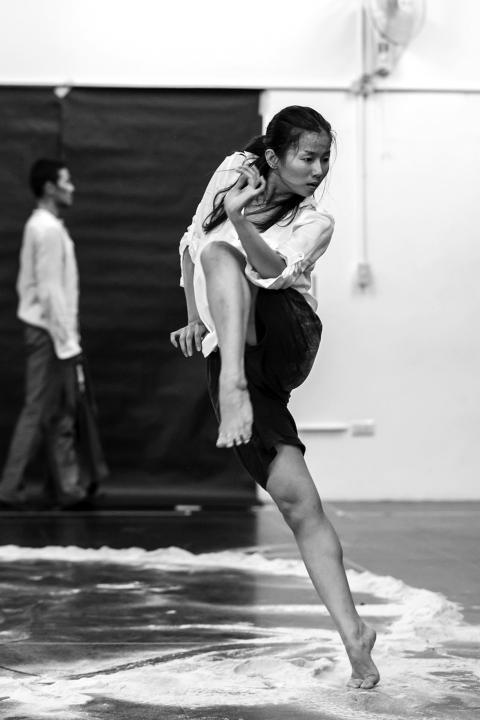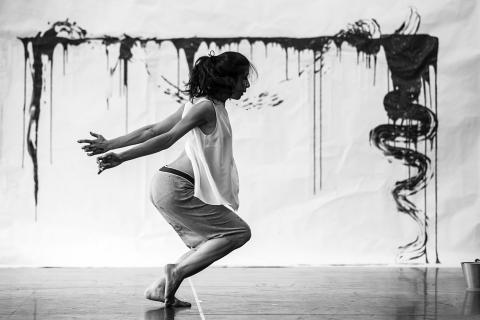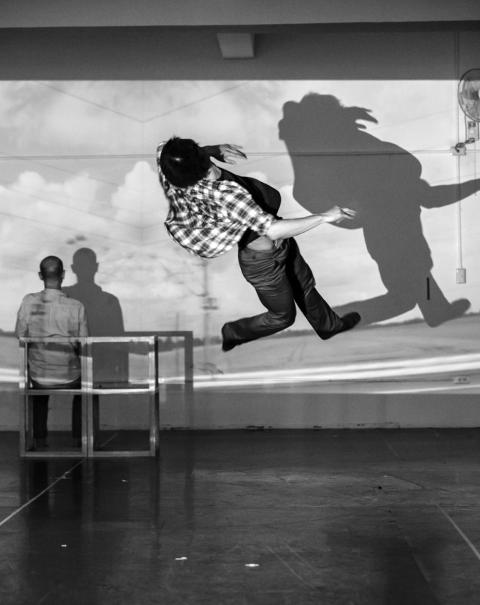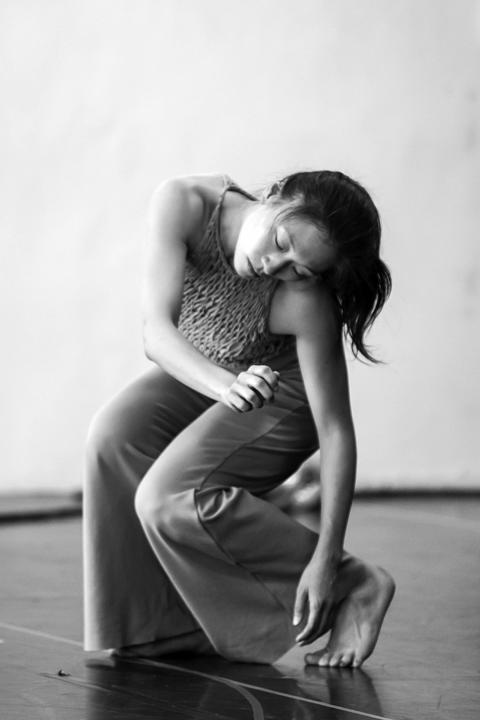Expatriates often have difficulty adjusting when they return to their home countries, whether for a visit or a permanent stay, and artists are no different.
Taipei National University of the Arts (TNUA) dance professor and choreographer Ho Hsiao-mei (何曉玫) says that Taiwanese dancers and choreographers going abroad to pursue their careers often leave home when they are young, so they do not always have a chance to absorb the changes Taiwan is undergoing. She thinks it is important for them to be able to stay in touch with the dance scene back home, so that both sides can see how the other is developing. That is why her Meimage Dance (玫舞擊) began hosting a new choreographers show three years ago.
The third Collecting Button show, with the theme of “Returning home to make new friends,” is taking place this weekend at the Eslite bookstore’s Xinyi Store before heading down to Greater Tainan for two shows next Saturday.

Photo Courtesy of Meimage Dance
For this year’s show Ho and producer Lu Chien-ying (盧健英) invited three TNUA graduates — Tsai Kuan-ling (蔡冠伶), Kao Pei-ling (高沛齡) and Chang Lan-yun (張藍勻) — and Yuan Shang-jen (袁尚仁). They then matched up the choreographers with four Taiwan-based designers or companies, asking the choreographers to include an object that dancer(s) could interact with, such as paint, wooden furniture, glass balls and sea salts.
Taipei-born, California-based Kao has been a freelance dancer for 15 years, though she has been dancing with the San Francisco troupe Molissa Fenley and Dancers since 2010. Her piece, titled The Best Defense, She’s Found, was inspired by a novel by Karl Jensen as well as her own life experiences. She was paired up with glass artist Lynn Lin (林靖蓉).
Tsai worked with Ku and Dancers (古名伸舞團) and Taipei Crossover Dance Company (台北越界舞團) before moving to Switzerland, where she danced with the Theatre of St Gallen dance company and the Zurich Opera House company. She is now based in New York.

Photo Courtesy of Meimage Dance
Her piece is titled Kio Restas (What Remains), for which she was paired up with The Escape Artist (藝甸園), the painting studio founded by jewelry designer Brendon Chen (陳建衡) and Lesley Hu (胡世恩).
Chang used to dance with Hong Kong City Contemporary Dance Company, after having previously worked with Taipei Crossover and Kaohsiung City Ballet (高雄城市芭蕾舞團), which featured some of her works in its Dance Show productions. She is now living in Gothenburg, Sweden, with her husband/dance partner. Their duet is titled Gray Tones (灰色調), for which she was paired up with a group promoting Taiwanese sea salts, and uses popular Taiwanese songs for its score.
Yuan, the only non-TNUA grad, studied ballet at Hong Kong’s Academy for Performing Arts (HKAPA). He was one of three HKAPA students selected for a four-month program at the Bolshoi Ballet Academy last fall and has also worked with the National Ballet of Portugal. He is now based in Bremerhaven, Germany.

Photo Courtesy of Meimage Dance
He is collaborating on his piece, Dialogue (對話), with Romanian choreographer Constantin Georgescu. It is about his experiences traveling, a kind of dialogue with his surroundings. Yuan was paired up with the Furnishings Gallery (四一玩作).
Lu said the aim of the Collecting Buttons project goes far beyond just providing an opportunity for the dancers to come back for a visit.
“Our project helps dancers to gradually reorient and reconnect to where and what they are from, emotionally and culturally. What they contribute today will be a base for when they move back home,” Lu said.

Photo Courtesy of Meimage Dance

May 18 to May 24 Pastor Yang Hsu’s (楊煦) congregation was shocked upon seeing the land he chose to build his orphanage. It was surrounded by mountains on three sides, and the only way to access it was to cross a river by foot. The soil was poor due to runoff, and large rocks strewn across the plot prevented much from growing. In addition, there was no running water or electricity. But it was all Yang could afford. He and his Indigenous Atayal wife Lin Feng-ying (林鳳英) had already been caring for 24 orphans in their home, and they were in

On May 2, Chinese Nationalist Party (KMT) Chairman Eric Chu (朱立倫), at a meeting in support of Taipei city councilors at party headquarters, compared President William Lai (賴清德) to Hitler. Chu claimed that unlike any other democracy worldwide in history, no other leader was rooting out opposing parties like Lai and the Democratic Progressive Party (DPP). That his statements are wildly inaccurate was not the point. It was a rallying cry, not a history lesson. This was intentional to provoke the international diplomatic community into a response, which was promptly provided. Both the German and Israeli offices issued statements on Facebook

Even by the standards of Ukraine’s International Legion, which comprises volunteers from over 55 countries, Han has an unusual backstory. Born in Taichung, he grew up in Costa Rica — then one of Taiwan’s diplomatic allies — where a relative worked for the embassy. After attending an American international high school in San Jose, Costa Rica’s capital, Han — who prefers to use only his given name for OPSEC (operations security) reasons — moved to the US in his teens. He attended Penn State University before returning to Taiwan to work in the semiconductor industry in Kaohsiung, where he

President William Lai (賴清德) yesterday delivered an address marking the first anniversary of his presidency. In the speech, Lai affirmed Taiwan’s global role in technology, trade and security. He announced economic and national security initiatives, and emphasized democratic values and cross-party cooperation. The following is the full text of his speech: Yesterday, outside of Beida Elementary School in New Taipei City’s Sanxia District (三峽), there was a major traffic accident that, sadly, claimed several lives and resulted in multiple injuries. The Executive Yuan immediately formed a task force, and last night I personally visited the victims in hospital. Central government agencies and the